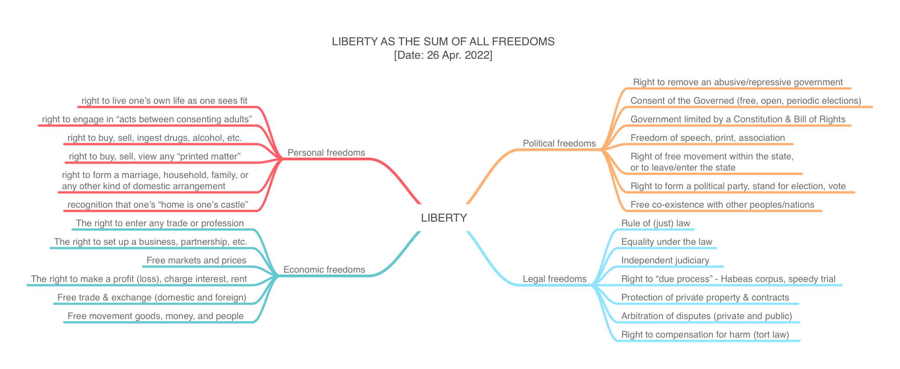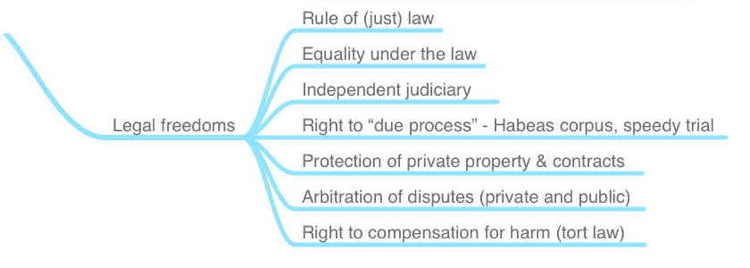[Note: This is an updated version of “The Key Ideas of Classical Liberalism: Foundations, Processes, Liberties” (23 June 2015) here.]
[Note: This post is part of a series on the History of the Classical Liberal Tradition]
In a recent post I discussed the “ends” that CLs sought and “the means” which they believed would help them achieve these ends. [See “What CLs were For – Part 2: Ends and Means” (19 Oct., 2021) here.]
Another way to approach the question of what CLs believed is to think of “Liberty” (with a capital “L”) as a “bundle” or “cluster” of smaller or partial freedoms or “liberties” (with a lower case “l”) which together make up what is “Liberty”. The following quote comes from Frédéric Bastiat’s essay “The Law” (June 1850). It should be noted that English has two word for “freedom” – a Germanic one “freedom” (die Freiheit) and a Latin one (via the French) “liberty” (libertas). I have used both to make the point I think Bastiat is trying to make clearer:
[French original] – Et qu’est-ce que la Liberté, ce mot qui a la puissance de faire battre tous les cœurs et d’agiter le monde, si ce n’est l’ensemble de toutes les libertés, liberté de conscience, d’enseignement, d’association, de presse, de locomotion, de travail, d’échange; d’autres termes, le franc exercice, pour tous, de toutes les facultés inoffensives; en d’autres termes encore, la destruction de tous les despotismes, même le despotisme légal, et la réduction de la Loi à sa seule attribution rationnelle, qui est de régulariser le Droit individuel de légitime défense ou de réprimer l’injustice.
[my revised translation 13 Aug. 2021] – And what is “Liberty,” this word that has the power of making all hearts beat faster and of moving the entire world, if it is not the sum of all freedoms? — freedom of conscience, teaching, and association, freedom of the press, freedom to travel, work, and trade, in other words, the free exercise by all people of all their non-aggressive abilities. And, in still other terms, isn’t freedom the destruction of all despotic regimes, even legal despotism, and the limiting of the law to its sole rational function which is to regulate the individual’s right of legitimate self defense and to prevent injustice?
The following “concept map” is an attempt to show the relationship between the four main components of “Liberty”, namely personal freedoms, economic freedoms, political freedoms, and legal freedoms.
The overview:

See a larger version of this image.
1. Personal Freedoms

Personal freedoms:
- right to live one’s own life as one sees fit
- right to engage in “acts between consenting adults”
- right to buy, sell, ingest drugs, alcohol, etc.
- right to buy, sell, view any “printed matter”
- right to form a marriage, household, family, or any other kind of domestic arrangement
- recognition that one’s “home is one’s castle”
2. Economic Freedoms

Economic freedoms:
- The right to enter any trade or profession
- The right to set up a business, partnership, etc.
- Free markets and prices
- The right to make a profit (loss), charge interest, rent
- Free trade & exchange (domestic and foreign)
- Free movement goods, money, and people
3. Political Freedoms

Political freedoms:
- Right to remove an abusive/repressive government
- Consent of the Governed (free, open, periodic elections)
- Government limited by a Constitution & Bill of Rights
- Freedom of speech, print, association
- Right of free movement within the state, or to leave/enter the state
- Right to form a political party, stand for election, vote
- Free co-existence with other peoples/nations
4. Legal Freedoms

Legal freedoms:
- Rule of (just) law
- Equality under the law
- Independent judiciary
- Right to “due process” – Habeas corpus, speedy trial
- Protection of private property & contracts
- Arbitration of disputes (private and public)
- Right to compensation for harm (tort law)
